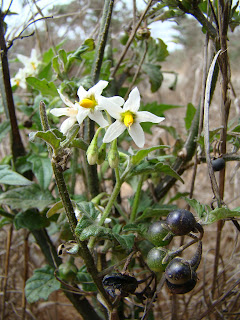Solanum douglassii
Greenspot Nightshade (Solanum douglasii) is a plant that I found growing on the Pacific coast of central California. It seemed to like to wind itself around other bushes. Anyway there are lots of species of Solanum but the fine specimen in question is Solanum douglassii, Douglas' nightshade.
Solanum douglassii stem. Notice white hair
Let's check the characteristics: the stem is covered with white hairs. Check. The leaves have smooth or toothed edges. My species has toothed and wavy edges. The inflorescence is an umbel-shaped array of small flowers. Check. Green spots at the bases of corolla. It took me a while to notice them but they are there. As a bonus, some plants had nice black berries growing. Native Americans used the berries medicinally though I don't know exactly what for.
Solanum douglassii flowers. Notice green spots on the petals
Some species of Solanum, like Solanum nigrum (black nightshade) are rumoured to be edible but you have to try it at your own risk. Also if you cook the leaves of the aforementioned black nightshade, like boil them 2 times for 15 minutes, it also supposed to make them edible but again, do it at your own risk as there is no guarantee that they are edible and toxicity within the species may vary greatly. Note that only ripe berries are edible. You have to be absolutely sure it's Solanum nigrum as some species look very similar to it but they are toxic.
Solanum douglassii flowers and black berries
Notice that the pictures in this post are of Solanum douglassii. I did not find information on its edibility.







